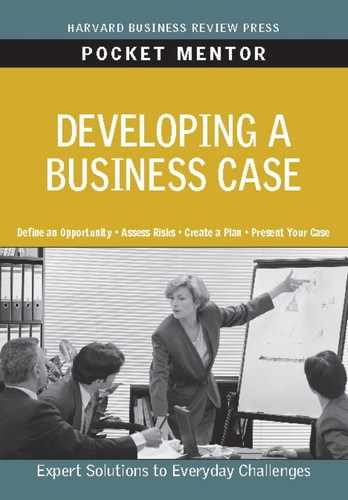Step 2: Identify
the Alternatives

Now that you’ve defined the opportunity you want to pursue, you need to identify alternative courses of action you could take to seize that opportunity. This step comprises the following tasks:
• Generate a list of options or alternative courses of action.
• Gather input from stakeholders.
• Narrow your choices down to a few especially promising ones.
Let’s examine each of these tasks in more detail.
Generating a list of options
While building a business case, it’s vital to brainstorm a full set of alternatives rather than latching on to the first one or two good ideas that occur to you. The following pitfalls can prevent you from developing a comprehensive list of alternatives:
• Restricting the list of choices to the first solutions you consider
• Having a limiting mind-set, such as believing that “consultants should never be used” or that “consultants should always be used”
• Having a strong preference for a particular solution at the outset of the process and therefore failing to explore additional possibilities
• Failing to consider the status quo (the current condition) as an alternative
To avoid these traps, convene a group of stakeholders and ask them to brainstorm ideas with you. These stakeholders are the people who would be affected by the outcome of your proposal—but they could be inside or outside your organization. Record the results of the brainstorming on a flip chart or white board, without judging them or discussing their potential pros and cons. Your goal is to generate as many feasible alternatives as possible.
Gathering input
Since a big part of building a business case is selling your idea, it makes sense to identify and talk with stakeholders early in the process so they feel more involved. They may also provide ideas and information you would not have thought of. You’ll also learn what they value most—thus, you can better appeal to their interests in your final presentation.
When Sydney conducts her brainstorming session, she invites her team members as well as key people in sales, finance, and HR. The participants come up with a long list of ideas for enabling the training group to help sales adopt the new solutions-selling strategy. These ideas include “add FTEs [full-time employees] in training department,” “hire curriculum consultants,” “use outside classroom facilitators,” “cancel low-priority existing projects,” and many other possibilities.
After generating a list of alternatives, meet with other stakeholders to get additional ideas for alternatives, as well as insights into the possibilities you’ve generated so far. Talking with trusted advisers at this stage is also prudent.
For example, suppose that after talking with other stakeholders Sydney discovers that Satellite’s finance and human resources departments have implemented a hiring freeze during the current fiscal year. In this case, she could decide to omit the alternative “add FTEs in training department” and focus instead on ideas such as using a training consulting firm or hiring outside classroom facilitators. Even if she decides to keep the FTE alternative under consideration, she’ll want to show why she believes it’s an important possibility and how it compares to using a consultancy or hiring outside contractors.
In the end, Sydney ends up with the following list of alternatives:
1. Try to support the new sales strategy with the existing training staff (the status quo option).
2. Add two permanent employees in the training group who will focus on implementing the new training.
3. Add two contractors to focus on the implementation.
4. Hire a consulting firm to do the work.
5. Borrow people from sales to help implement the training.
Always think outside the box and embrace opportunities that appear, wherever they might be.
—Lakshmi Mittal
“Steps for building support for your business case” provides additional ideas for using communication with stakeholders to establish support for your case.
Narrowing your choices
Once you have received input from stakeholders, it’s time to narrow your list of alternatives down to the two or three options—in addition to the status quo—that will best address your business objectives and stakeholders’ needs. Strategies for narrowing your choices include the following:
• Combine any alternatives that could reasonably be implemented together.
• Eliminate elaborate, high-risk options.
• Favor the easy-to-implement solution over the complex and difficult.
Don’t spend too much time agonizing over this step. Instead, go with your intuition about which choices seem the most feasible and likely to meet your objectives. At this stage, you will likely want to depend more on your hunches and professional judgment than a careful analysis of each alternative.
Consider Sydney’s case: Since she knows that Satellite executives will resist adding permanent headcount immediately, she decides to combine her original options 2 and 3 into a single solution: hiring two contractors with the intent that they may become permanent employees in a year. She also knows that sales is already understaffed, so she deletes option 5 (borrowing people from sales to implement the training).
Thus, her final list of alternatives is as follows:
1. Hire a consulting firm to develop and deliver the training.
2. Add two contractors to provide the training, with the option to hire them as permanent employees after a year, if necessary.
3. Try to implement the new training with the existing staff (the status quo option).
